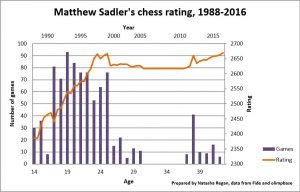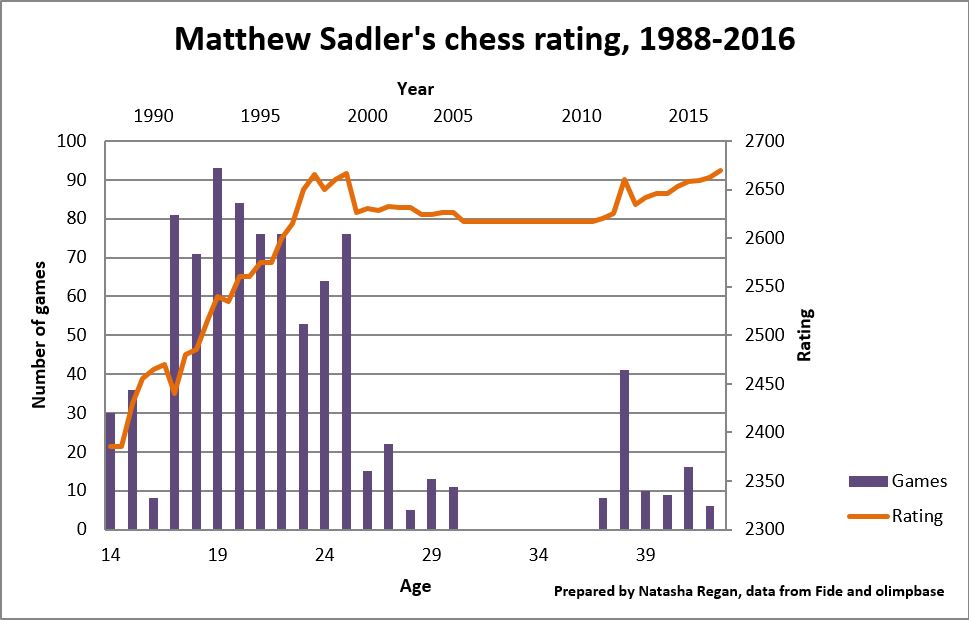When work gets tough, I always look to chess – now just a hobby for me – for some joy and relief. So it was a nice boost to get a mail from my Dad at the beginning of April, pointing out that I’d just achieved my highest ELO rating ever – 2670 – beating my previous best of 2668 in January 1999! To celebrate that, I asked Natasha if she could make a “Chess for Life” chart for my career, just as she’d done for our role models. And here it is – thanks Natasha!

Looking back, I made smooth, consistent progress from the age of 14 until my retirement towards the end of 1999… but it didn’t feel that way! The period immediately after turning professional at the age of 16 was difficult: you can see a little dip in rating before I started climbing again. I was also a hair’s breadth away from stopping in 1995, worn out and driven to distraction by the painful process of pushing my rating from 2550 to 2600. You can see this struggle in the “staircase” pattern in my rating chart around that time: little steps forward followed by periods of stagnation or consolidation, depending on your viewpoint!
After my return to playing chess (albeit as an amateur now) I had a wonderful 2011, winning 2 strong international opens and peaking at 2662 before a disastrous start to 2012 brought me back down to earth! Since then, I’ve played a lot less but managed to play quite well on my infrequent outings.
This brings back a lot of memories! The fondest ones are probably of the period between 1996 and the end of 1998, during which I won a Gold medal for England at the 1996 Yerevan Olympiad, shared in the team’s success when England won the European Team Championships in 1997 and finished =3rd in the Category 18 Tilburg tournament of 1998. Happy days!




Matthew – I was recently fortunate to discover a pile of old Informators where the previous owner had highlighted the results of English players. It would seem that your early career was no less spectacular than the period you talked about above.
88/89 Hastings Challengers – a half point behind J Polgar.
89 London Open – 3rd= with Smyslov, ahead of Adams and Bronstein
91 Cappelle – 1st
92 Politiken Cup – 1st=, ahead of Krasenkow – held that year in Copenhagen or Helsingor?
93 Budapest – 1st
94 Cuxhaven – 1st=
94 Gausdal – 1st
94 & 96 Ischia – 1st
95 & 96 Cannes – 1st
… the list goes on … not forgetting the win at ’97/98 Hastings Premier of course. Very impressive!
Some questions …
1. Any special memories of this period for you?
2. Which tournaments were your GM norms achieved at?
3. Regarding the Intel GP Rapid (Paris ’94) – was the furore over your qualification in any way psychologically difficult for you? Your opponent Vyzmanavin was in any case a super strong player who somehow always slipped under the media radar (now sadly departed). Any memories of him at all? – I see you both participated at Ostend in 1991 as well.
– Thanks, Matthew. No rush – you will be mighty busy with the ‘Chess For Life’ tour.
Great book by the way!!!
Hey Colin, nice to hear from you! Budapest in 1993 was a very special tournament – I got my final GM norm there in a pretty useful all-play-all tournament and played very well. In particular, I was very happy with my endgame win over Peter Leko and my last game against Liss (later a GM himself) is one of the best games I’ve ever played. My Dad had promised that the whole family would fly over wherever I achieved my GM title, and he kept his word! We celebrated the event by staying a few extra days in Budapest. My brother – a concert pianist – was thrilled to visit Franz Liszt’s house! I also achieved GM norms at Hastings and the Lloyds Bank Masters.
The Paris tournament was one of those things that seems natural to you, but looks completely different to other people. Especially in those days, I felt just as French as English (as I have a French passport, I’d played as a French player in the French league) so it seemed quite natural to qualify as a Frenchman. But it came as a surprise to a fair number of people. Ah well, you live and learn. I played a little flat against Vyzmanavin but he was a very strong rapid player so I don’t think I was the favourite. I think he only spoke Russian so I never chatted to him!
Glad you like the book! Best Wishes, Matthew
Thanks Matthew – I probably managed to both steer off-topic and wreck the formatting (maybe I used too many line breaks?) at the same time – apologies for that. It is quite remarkable that you have been able to resume playing at your old rating, let alone surpass it, particularly when you see how few games you’ve played (i.e. in comparison to that large grouping to the LHS of the chart). I guess it’s partly a testimony to your love and thorough understanding of the game that you can treat it like a hobby and yet, still look at things with great depth and precision. It is interesting that so many grandmasters fall back quickly when out of match practice, when others, like yourself, Nigel Short, Alexander Beliavsky, and most recently Julio Granda, maintain a level close to their best. As is well explained in the book, there are also those tips and systematic changes that we can all employ to stand a better chance of longevity. On your recommendation, I tackled Keith’s methodology and endgames first and actually began to enjoy the latter phase of the game, probably for the first time. A far cry from the time I sat down and tried to read Reuben Fine’s book cover to cover! The YouTube videos have also helped with the absorption process. Some great teaching skills on display. Only time will tell whether I have the learning skills to match! Anyway, good luck with the book and the rest of the tour.
Hey Colin, yes it seems to be the line breaks that do all the damage! I’ve corrected them so now your post looks a lot better. I guess we can also add Johann Hjartarson to the list now after his recently drawn match with Nigel Short in Greenland! Glad you’re enjoying the videos! I really like them as a way of communicating and it makes a nice change from sitting behind my computer typing stuff!
I’ve just done a little series of blog postings on the basic techniques in R & P vs R endings so I’ll put those up probably in the next few weeks. Hopefully they can fuel your love of endings! Best Wishes Matthew